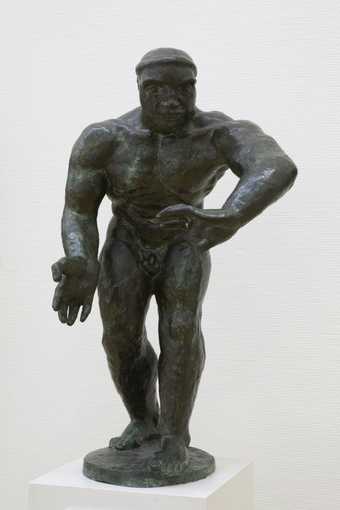Have just bought two statuettes from the coming sculptor, Gaudier-Brzeska. I like him very much. He is the only person with whom I can really be ‘Altaforte’
We are getting our little gang together after five years of waiting.1

Fig.1
Henri Gaudier-Brzeska
The Wrestler 1912, cast 1945
Bristol Museum and Art Gallery
The words above are by Ezra Pound writing to fellow American poet, William Carlos Williams, in December 1913 after he and Dorothy Shakespear had just purchased two of Henri Gaudier-Brzeska’s sculptures, Torso 3 and Samson and Delilah, using money from a poetry prize awarded by the great Irish poet W.B. Yeats.2 Pound had first encountered the work of Gaudier-Brzeska while visiting the Allied Artists Association exhibition in the Royal Albert Hall just a few months previously in July 1913: ‘“International,” “Allied Artists,” or something’, Pound wrote dismissively of the London exhibition scene. Dispensing disparaging remarks and ‘playing the fool’ as they took in the show, Pound and Olivia Shakespear, his future mother-in-law, were apparently stopped in their tracks by ‘a figure with bunchy muscles done in clay painted green’. This was Gaudier-Brzeska’s small freestanding sculpture, The Wrestler (fig.1). Thumbing through the catalogue to find out who had made the piece, Pound was halted for the second time that day; this time, he recalls, by an ‘appalling assemblage of consonants’. This was the word ‘Brzeska’ as it was printed in the catalogue.3 That day Pound not only encountered the sculpture but also the sculptor himself who, after darting from behind the pedestal to correct Pound’s terrible pronunciation of his name ‘with the gentlest fury in the world’, disappeared ‘like a Greek god in a vision’, or so Pound recounted in his memoir of the sculptor.4
It seems significant that Pound and Gaudier-Brzeska met in front of one of his wrestling sculptures. In the short period between first meeting one another at the Allied Artists exhibition in 1913, Gaudier-Brzeska and Pound established an intimate friendship in which they often engaged in ideological combat together, or in support of one another, against their contemporaries.5 ‘The New Sculpture’, published in the radical, anarcho-individualist journal the Egoist on 16 February 1914, was Pound’s first real piece of art criticism, although, as literary historian Rebecca Beasley has aptly demonstrated, the poet had been engaging with writing about the visual arts in published and unpublished work before this date.6 The back page of this issue of the journal also carried reproductions of two pieces by Gaudier-Brzeska and one of his drawings. This article was, among other things, a call for a new conception for the role of the artist and alighted on the work of the sculptors Pound had recently encountered in London, the American Jacob Epstein and Gaudier-Brzeska.
Sculpture and sculptors were clearly central to Pound’s ‘gang’, and, more broadly, to the conception of a radical, militant avant-garde art that he was promoting on the pages of the Egoist. The article was a manifesto for ‘this new wild sculpture’. Pound envisaged the restoration of a hierarchical cultural code through ‘craft’ and ‘violence’, resulting in the renewal of the moral and spiritual potential of the artist’s craft and labour.7 In this essay, Pound associated this ‘new wild sculpture’ with a violence and combat that suited his own pugnacious rhetoric. Pound and Gaudier-Brzeska shared and responded to each other’s ideas about violence, force and creativity and established a critical relationship which started with a fortuitous and somewhat appropriate meeting in front of one of Gaudier-Brzeska’s sculptures of a wrestler. It is in the spirit of the strong ties that Gaudier-Brzeska and Pound forged between sculpture, poetry, art criticism and a rhetoric of combat that the contemporary poet S.J. Fowler, who is also a trained wrestler, has written a response to Wrestlers.
